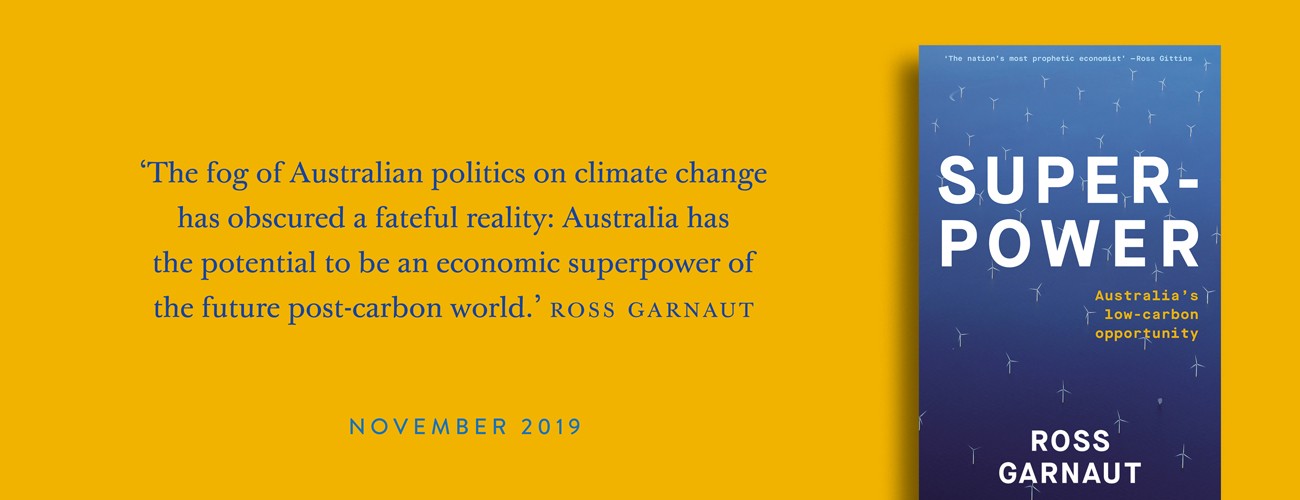News

News >
Superpower: read an extract
Read an extract from the new book by Ross Garnaut, Australia’s leading thinker on climate and energy policy.
In the first half of August 2019, my wife Jayne and I took a journey through the Murray–Darling Basin. We spent a couple of days at Lake Mungo, where the ice age overflow from the Lachlan once filled lakes and supported communities that left us with what may be the oldest record on earth of complex human mind and spirit. Then we turned up the Darling to Menindee, where Harrison made his pile when Pardon won the cup. Once the source of Broken Hill’s water, and of renowned grapes and fruit, in the past year the Menindee Lakes have been famous only for a plague of dead fish. They are mainly dry. A new pipeline is raiding the Murray to supply Broken Hill. We cut across to Wilcannia, once a bustling port collecting wool and copper ores brought in by camels and bullocks for shipping down the river to Goolwa and Port Adelaide. Here was a little water, held back by the barrages, low and still. Finally, we crossed the Lachlan at Hillston and the Murrumbidgee near Griffith, and returned to the magnificent but weakening Murray once more. This was beautiful Australian country, rich with the human heritage of 50,000 years and 200 years.
For many Australians, their personal heritage lies in the Basin. Jayne’s father, Tom, lived in Wentworth and the lower Darling until he and many others in the bush rode to Melbourne on the news of war in 1914. That ride led him to a beach in Turkey, as the rising sun lit the coastal hills on 25 April 1915. A decade ago, a board in the Wentworth RSL club remembered Tom and his brother. This building without its memorabilia is now empty beside the Darling.
What value do we place on Australian heritage? The question kept coming back as we travelled the Darling. For about 30 kilometres the bottom of the riverbed is wet from the flowback from the Murray. But beyond that, the sand between the rows of grand old river gums is dry, except for scattered stagnant pools. By one of these lay the skeletal head of a Murray cod, its mouth gaping wide enough to swallow the largest carp whole. The dried flesh on the cod’s back had been gnawed by wild pigs, which had waded into the shallow pond and dragged out the helpless survivor of eighty summers and a dozen droughts. Around a fire on the riverbank one night, we were told of plans for a quad bike ride along the Darling bed from just north of Wentworth to the arid Menindee Lakes.
Mike Sandiford, professor of geology at the University of Melbourne, is using new, satellite-based remote-sensing techniques to map the water contained in the structures below the surface in the Darling Basin. For millennia, water in occasional floods has filled porous sands and cavities and seeped out to maintain the life of plants and animals through the long dries. But now these occasional floods are treated as surplus, and held back for irrigation in the northern Darling and its tributary, the Barwon. Professor Sandiford foresees lower run-off from higher temperatures, reduced average rainfall and more insistent demands of irrigation interacting to contrive the desertification of the Basin. These factors are reproducing the fate of the Tigris and the Euphrates several thousand years ago, when the riverways that nurtured the beginnings of agriculture and human civilisation evaporated into today’s Iraqi deserts.
But in one way, this tragedy is different from that of the original Garden of Eden. The Adams and Eves of Mesopotamia had not eaten of the tree of scientific knowledge; they knew not what they did.
But we do. The tragedy of the Murray–Darling is a consequence of denial, and of knowledge not being applied to public policy.
This was not always the Australian way. In June 2019, I spoke at Bob Hawke’s memorial service of the great Australian prime minister’s conviction that broadly shared knowledge was the foundation of good policy in a democracy. And just one day after returning from the Darling, I presented a memorial lecture for one of Australia’s greatest public servants. John Crawford’s essential contribution to Australian public life was his commitment to knowledge based on research as the starting point for sound policy development. It was through Crawford that I met Hawke in the late 1970s, while working on a report for Prime Minister Malcolm Fraser on the future of Australian industry. I was inducted into a great Australian tradition, of which Hawke and Crawford were the most accomplished proponents in their respective spheres.
But today, public policy based on marshalling knowledge through research and analysis, and then nurturing public understanding of the issues, seems a distant dream. That it is not contemporary reality is the essential problem behind the tragedies of the Murray–Darling Basin and of policy on climate change and the energy transition.


